Over the last few centuries of the existence of mankind, coffee has become an integral part of the life of almost all of us. In order to brew this delicious drink correctly and with high quality, many different dishes and appliances were invented. The most popular of them are Turk and Cezva, today we will analyze their main differences.

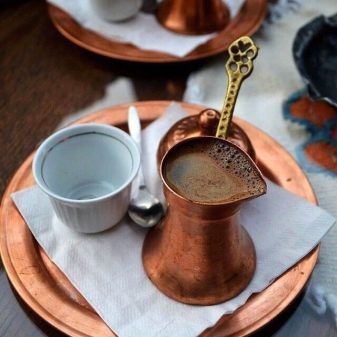
A bit of history
A vessel with an unusual name ibric called the first utensils for brewing coffee. At its core, it's just a beautiful jug. Its long nose is well suited for pouring hot liquid, and the design itself withstands long-distance transport in bags. Usually, irises were not made large - their volume did not exceed 300 ml. But nothing prevented them from having large sizes, since they could be used to store water.
They were replaced by dalla. It became popular during the delivery of coffee to Arabia. In those years, it ceased to be considered a drink of commoners and confidently entered the diet of rich people.
That is why the dalla, although it was also an ordinary jug, looked much richer, more picturesque, more luxurious.
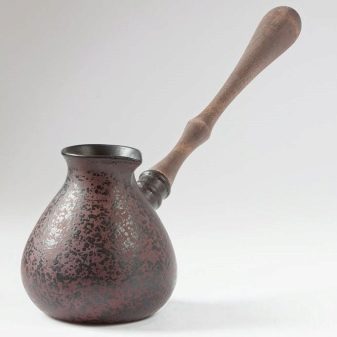
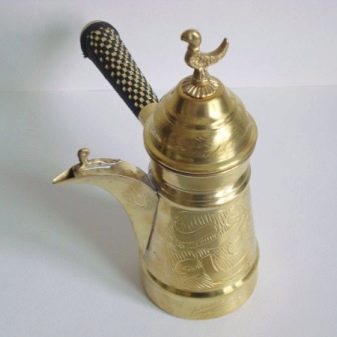
Its main differences were the chased pattern and the material of manufacture itself - metal instead of clay. In addition, dalla was used exclusively for coffee, and not for water. Gradually, they began to make it cone-shaped, and thus the cezve turned out, which we are all used to today.
After some time, another interesting device was invented - percolator. So he was called by the inventor (French priest) from the word percolare - "leak out, penetrate."The whole structure consisted of two parts and worked quite simply. Ground coffee was poured into the upper bowl, in the walls of which holes were made, and it was poured abundantly with boiling water. The liquid seeped into the lower container already saturated, that is, in the form of a tasty, invigorating, aromatic drink.
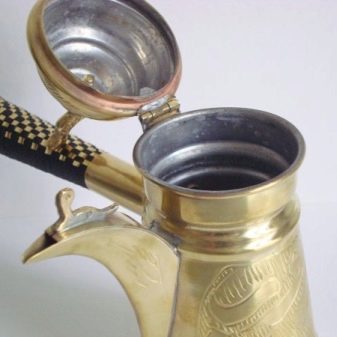
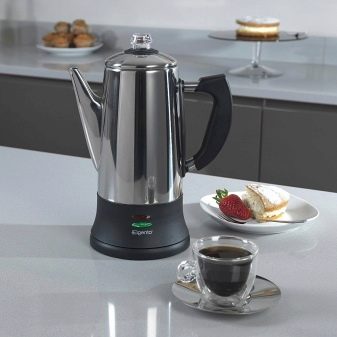
What is cezve?
This rather exotic word from Turkish translates as "Hot coal." Such a beautiful name was invented for a container that helps brew ground coffee beans. Moroccan or any other classic cezve represents an elongated vessel with thick walls, a very wide bottom and with a long, possibly wooden handle.
According to traditions, this device is made of copper, and inside it is covered with a special tin that is safe for the human body. The fact is that copper itself as a material of manufacture when heated adversely affects the human body. That is why you have to apply another layer from the inside.
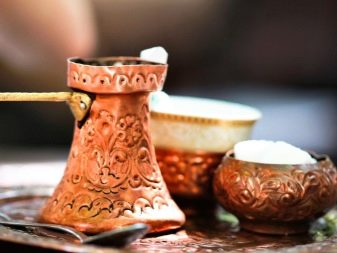
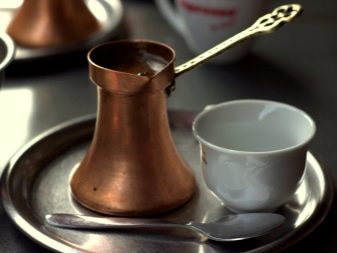
This metal is good heat conductor and quite durable in operation. Before brewing coffee, check if the inner coating is in order: if copper is visible there, then you cannot use a cezve. Sometimes in more expensive models, the inner coating is made silver.
Such a variation really has useful properties due to ions, but such a product will not only cost more, but it is not so easy to find it.

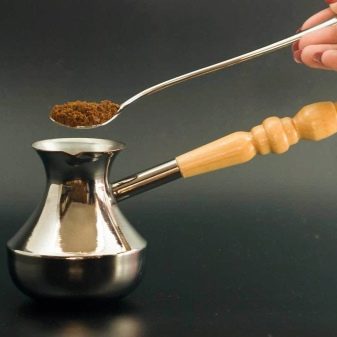
Manufacturing options
As mentioned above, most often the cezve is made of stamped copper, but sometimes forging is also used.. The first option allows you to make the cezve walls thinner, and in the second case, the walls are thicker. The thin walls of the vessel make the process of preparing the drink faster, however, the service life of the cezve is reduced, and the quality of the coffee is degraded. Forged model implies more uniform heating and a long service life. Most often, these are more expensive, but very beautiful cezves, their walls are decorated with neat carvings, and the handles are made of durable wood.
According to tradition, such thick-walled containers were used to make a delicious drink in the sand. To do this, the latter, along with pebbles, was heated so that a hot mass was obtained, and a cezve was placed on top. Thus, excellent coffee came out, which today is impossible to make even in the best coffee machine.
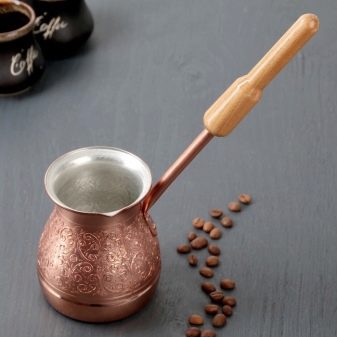
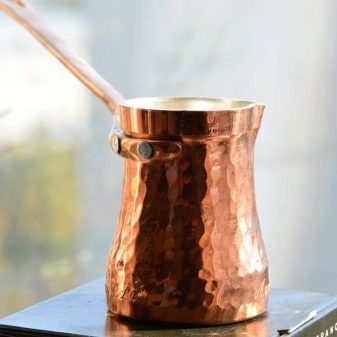
For novice coffee lovers who want to prepare this aromatic drink in cezve, you can choose quartz product. Mountain quartz allows you to make the walls completely transparent. Accordingly, you can always notice in time when the water begins to boil and turn off the fire, so as not to spoil the taste of coffee and not to dirty the stove. In addition, this embodiment looks very nice and unusual. At first glance, it even seems that the product is made of glass, but at the same time it is resistant to high temperatures.
There are also options for making cezves. made of chinese clay. However, such a performance is less common than all others. Among the advantages of this option, it is possible to note the heterogeneous structure of the clay, which allows you to further saturate the coffee with oxygen. The aroma of the drink brewed in this vessel is truly saturated and very pleasant.
If you look at yourself a cezve, but you can’t decide on the material, then take anything except stainless steel. This, perhaps, will last longer, however, it will adversely affect the taste of the drink. Coffee, even the most expensive and delicious, when brewing in it, will acquire a taste of metal.
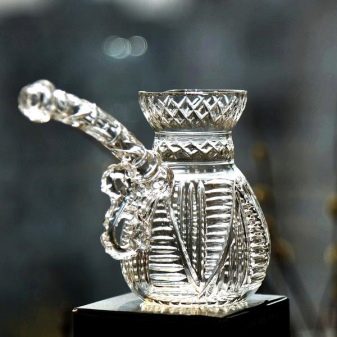
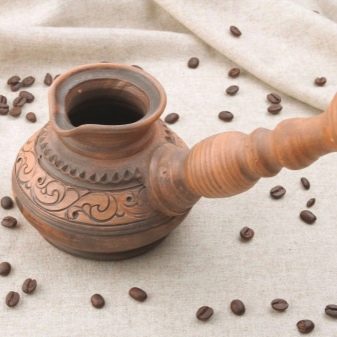
How to choose?
When choosing a cezve, you must adhere to the following recommendations.
- You need to pay attention to the pen. A removable model will be the best choice, in which case you can not only better clean the entire structure, but also replace the handle if it is uncomfortable for you.
- Regarding volume, then you should not choose too large a capacity, unless, of course, you do not count on making at the same time a large amount of coffee. To prepare one serving of a fragrant drink, no more than one hundred and fifty milliliters is enough. And most coffee recipes are designed for such volumes! But if you have a large family and everybody wants coffee in the morning, then you can safely buy a 0.5 liter vessel.
- If you choose the shape of the product, then the cone-shaped models with a thin neck are perfect for continuous use. This is convenient and practical, since this configuration allows you to quickly heat the water, and the brewed coffee will slowly cool.
In addition, this design retains the aroma of the drink.
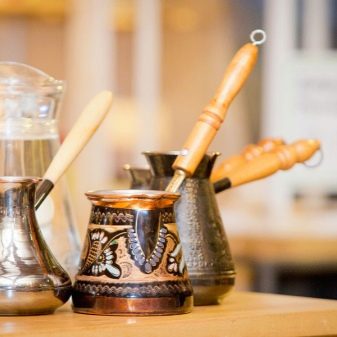

Is Turk and Cezva the same?
Turk is the name of a cezve that has taken root in our area.
Since the original name was unpronounceable for native speakers of the Russian language, they began to call this device, focusing on where we came from the tradition of drinking coffee. In this case, we also mean the traditional Turkish method of brewing - on sand and pebbles.
Most often, in the manufacture of the Turks, copper is not preferred, although such options are also present.
Most of all in stores of such products ceramicThey are common and inexpensive. There are also products made of brass. Of course, you can find the classic versions of stainless steel, clay and copper. Both shape and volume may vary.
Despite the similarities, some differences between Cezve and Turk are still present, since the latter option is more adapted to the needs and requirements of modern man. Cezva traditionally has a narrower neck, while in the Turks it is funnel-shaped. But according to their functionality, both options are considered identical.
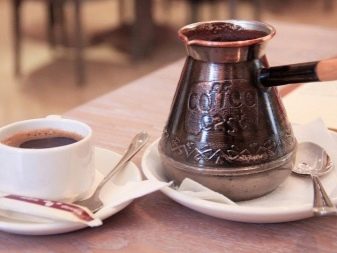
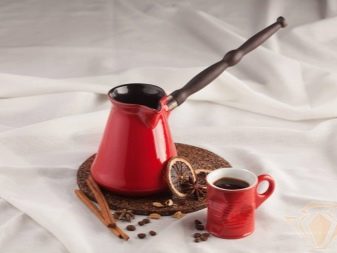
Fidelity to tradition
A coffee Turk or cezve, as it was originally called, has occupied a place of honor in the kitchen of a lover of a tasty, aromatic drink for many years. Over time, new varieties of coffee were developed, new recipes for its preparation appeared, and modern units for brewing a drink were created. However, despite modern alternative solutions and technologies, Turk still remains in demand and loved.
A huge number of coffee connoisseurs refuse to accept any other devices, and still brew their favorite drink in a beautiful copper cezve.
They are fully confident that the best coffee can only be obtained using high-quality Turks and therefore do not change traditions.
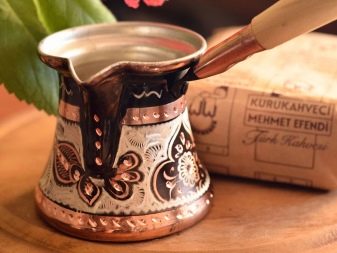
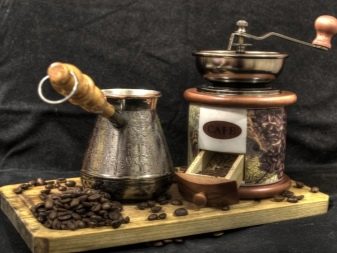
See how to brew coffee in a Turk correctly in the next video.










